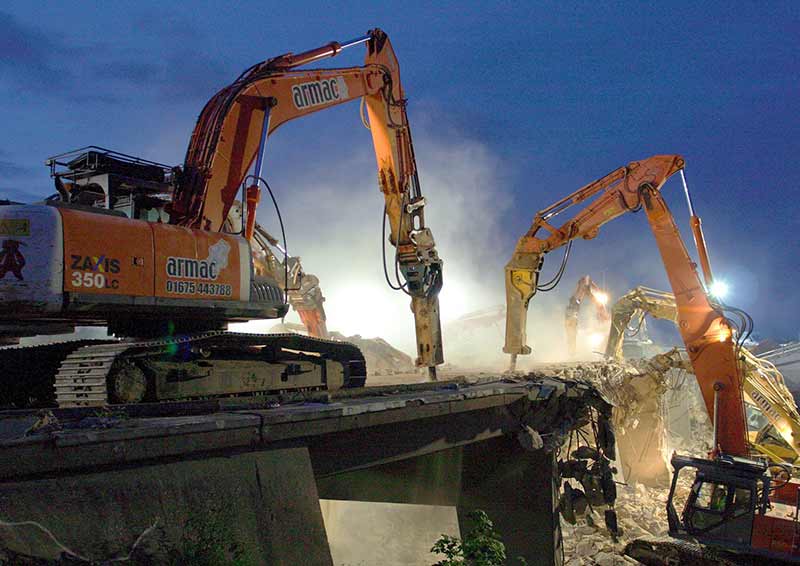Recyclable construction materials
There is an established tradition for salvaging and recycling building and construction materials. For hundreds of years after the end of the Roman empire, groups plundered buildings as a source for new materials. Often, skillfully-worked stone masonry and fired clay products were incorporated into altogether cruder new buildings.
Demolition waste has long been broken down and used as foundations and sub-bases for new construction, roads and other pavements. There is now a movement towards, and encouragement for, recycling old concrete as crushed aggregate for new concrete, although there can be legitimate concerns and certainly more caution must be exercised with respect to fine aggregate.
More valued building elements, such as ashlar blocks, bricks, roofing slates, tiles, lintels, flooring tiles and decorative items, have long been recovered and re-used. In recent times, as we have become more sensitive to the need to minimise waste and maximise re-use, this trade has organised itself into centres where items can be sold, sorted and purchased.
Alongside this admirable recovery and re-use of construction materials, there has been a gradually increasing role for redundant or waste products. Large quantities of industrial wastes and by-products, such as slags, have found extensive and largely beneficial uses in construction and this trend is increasing.
Civil engineers will be aware of many other examples of this growing endeavour to consume waste or previously-used products as an alternative to extracting or making new construction materials. However, it is a constantly changing situation, partly because the availability of wastes or by-products can and does fluctuate.
Two extremely popular construction materials in common usage worldwide; blast-furnace slag by-product from the iron and steel industry in its ground granulated form, and fly ash waste (including pulverised-fuel ash) from coal-burning furnaces, might face at least regional supply shortages going forward.
Some of the former large producers of iron and steel, including the UK, are increasingly focusing on specialist rather than bulk production, with consequently reduced slag outputs, although interestingly, there could soon be a new lease of life from the processing of recycled iron and steel materials.
In the case of fly ash and other types of produced ash (such as rice husk ash), this possible shortage could be more profound worldwide as there is a global move away from coal and other carbon-burning for environmental reasons.
Thankfully there are still many recyclable construction materials in plentiful supply, and a themed issue of the ICE Construction Materials journal published in April 2016 provides a useful update on their use. This ranges from the design, specification and maintenance of concrete made from recycled aggregates to using crushed brick as a non-metallic reinforced-earth fill material and glass waste in polymer concrete.
This article originally appeared as 'Construction recycling – it's all about supply', published by the Institution of Civil Engineers on 30 March 2016, written by Ian Sims.
--The Institution of Civil Engineers
[edit] Related articles on Designing Buildings Wiki
- 5 things leaders can do to create a truly circular economy.
- Achieve safety in demolition.
- Articles by ICE on Designing Buildings Wiki.
- Arup and Better Shelter at the Working Together For Disaster Relief conference.
- Buying green in the construction industry.
- Circular economy.
- Daub.
- Demolition.
- Design for deconstruction.
- Dismantling.
- Disposal.
- End of life potential.
- Ethical sourcing.
- Green Seal.
- Hire, reclaim and reuse scheme combats construction waste.
- India looks at using plastic instead of sand.
- K-Briq.
- Managing packaging waste streams.
- Material procurement.
- Mean lean green.
- ReCon Soil project.
- Recycling.
- Recycling machine.
- Reduce, reuse, recycle.
- Reused construction products.
- Site waste management plan.
- Sourcing.
- Sustainable materials.
- Sustainable procurement.
- Waste and Resources Action Programme WRAP.
- Waste hierarchy.
- Wishcycling.
About the wiki
Anyone is welcome to use and contribute to the wiki in different ways.
[edit] Engaging with the wiki
You can:
- Contribute to existing articles
- Create articles
- Share articles through social media and other channels
- Contact the CIRCuIT project to let us know what you think and how we can improve
[edit] Add your own content
To contribute to or create an article, you can follow these steps:
- Register as a user
- Read through the editorial policy and guidance on writing and contributing to articles
- See the detailed help page on tips on writing wiki articles
- Try editing a test article
- If editing an article, select 'Edit this article' underneath the article title
- If creating a new article, select 'Create an article'. In the 'Select categories' area, expand the 'Industry context' list and tag 'Circular economy' to add your article to this wiki
[edit] Who is this wiki for?
The articles contain information on implementing circular economy approaches in construction that could be relevant to:
- Architects
- Construction contractors
- Designers
- Developers, owners, investors
- Engineers
- Landowners
- Manufacturers and supplier
- Universities and research
- Urban planners
[edit] About CIRCuIT
The Circular Economy wiki is supported by the Circular Construction in Regenerative Cities (CIRCuIT) project, which is funded by the European Union's Horizon 2020 research and innovation programme. CIRCuIT is a collaborative project involving 31 ambitious partners across the entire built environment chain in Copenhagen, Hamburg, Helsinki Region and Greater London. Through a series of demonstrations, case studies, events and dissemination activities, the project will showcase how circular construction practices can be scaled and replicated across Europe to enable sustainable building in cities and the transition to a circular economy on a wider scale.








Comments
Very informative. Our team is actually thinking of acquiring RA from one of these aggregate suppliers that was recommended to us. And I’m so glad we considered getting them. Glad to help with minimising waste and maximising “re-use”.